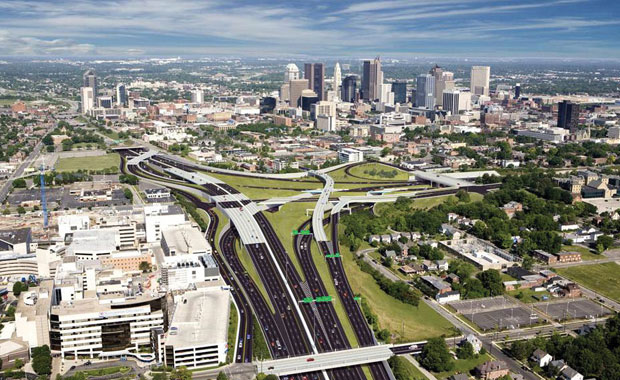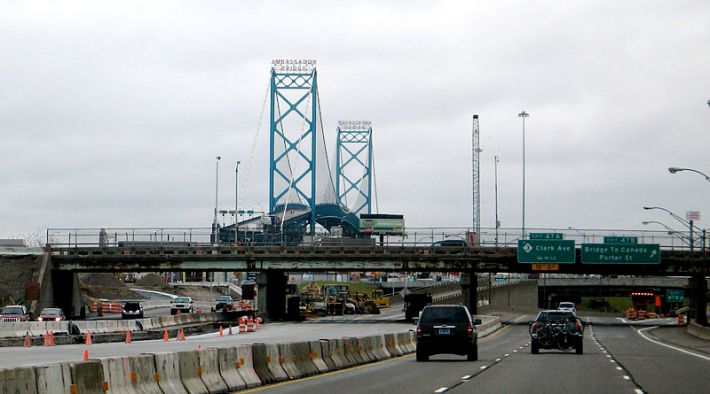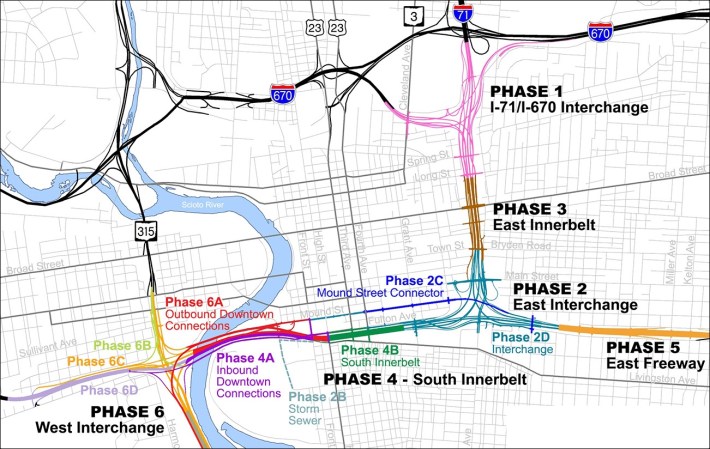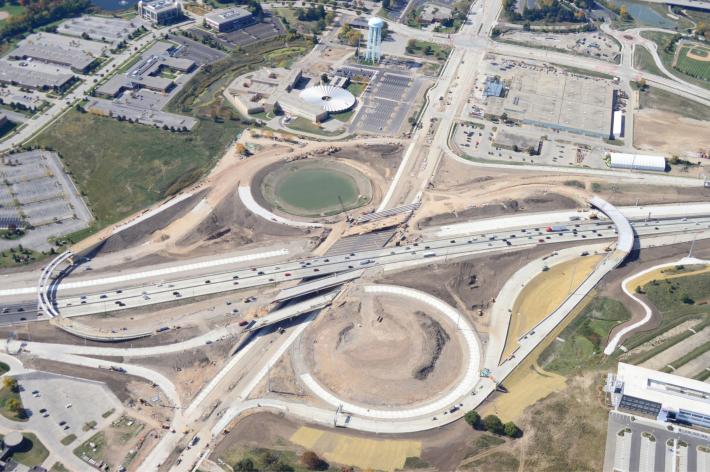Midwest Will Raise Gas Taxes — And Make Everything Worse
4:45 PM EST on March 7, 2019

More highways. Image: ODOT
Higher gas taxes are (likely) coming across the Midwest, framed by Ohio, Michigan and Wisconsin Democrats and Republicans alike as an offensive against potholes — but in reality a boondoggle that will soak taxpayers and create more of the car dependence that has devastated Midwestern cities like Detroit, Cleveland and Milwaukee.
Here's how the saga continues in three Rust Belt states — each with slow- to no population growth, yet big appetites for highway expansion projects:
Michigan

Michigan Governor Gretchen Whitmer, a Democrat, has proposed a 45-cent gas tax hike, the steepest of the three states. It would amount to a near tripling of the state's gas tax, and raise up to $2.5 billion a year.
Whitmer campaigned on road conditions, capturing her enthusiasm for repairs on a campaign web page titled, "Fix the Damn Roads."
"The dire state of our highways is endangering our people and getting in the way of our economic prosperity," she wrote.
But Michigan DOT hasn't been sparing many expenses when it comes to highway expansion.
The state is planning two highway projects for the Detroit region alone totaling $4 billion. According to official population estimates, Southeast Michigan's population grew only about 1 percent between 2010 and 2018. The growth that did occur was concentrated in the suburbs that these highways are designed to serve. During the same period, Wayne County — where Detroit is located, lost 3.8 percent of its population. Meanwhile, suburban Oakland County grew 4.5 percent.
The majority of road widening for the Detroit area — which transit advocate and Ph.D. student Joel Batterman estimates at about $1 billion — is concentrated in two counties: Oakland and Macomb County. These are the two counties that voted against transit expansion for the region in 2016, preventing Detroiters from accessing desperately needed service.
Batterman argues highway expansions for these areas — which are unwilling to support transit — shouldn't be "automatic" because they "fuel sprawl" that has made the region notoriously inequitable and uncompetitive.
Ohio

In Ohio, Republican Governor Mike Dewine has proposed an 18-cent gas tax hike.
Gas tax revenues are down in Ohio. The state's 28-cent gas tax hasn't been raised since 2005 and has lost much of its spending power to inflation.
But Ohio also hasn't been skimping on big highway expansion projects either. Former Governor John Kasich mainly borrowed to cover costs, rather than tightening the belt or raising taxes.
In the last few years, Ohio DOT has poured $1 billion into rebuilding the I-70/I-71 split, which walls off downtown Columbus from every neighborhood to the south. Pictured above, it was built in nine separate phases. In addition, the agency recently built a $400-million bypass for Portsmouth (population: 20,000 and holding). Thanks to expensive private financing, however, the final bill to Ohio taxpayers will be $1.2 billion.
The Cleveland Plain Dealer's Rich Exner recently listed 10 projects that would be scaled back of cancelled if Dewine doesn't get his way. They are all sprawl widening projects serving the sprawl suburbs, with the exception of one urban highway project.
According to a study undertaken by civic leaders in northeast Ohio — metro Cleveland/Akron/Youngstown — added 300 highway lane miles since the 1990s.
These kinds of low-value projects not only add to the agency's overall maintenance costs, it is also harmful to older cities, helping facilitate the continued exodus from older urban areas.
Not only has Cleveland lost more than half of its historic population, the region's urban county — Cuyahoga — has been shedding residents at an alarming rate. Some of those folks move to other metro areas — notably Columbus. But by far the biggest gainers at the surrounding exurban counties.
Akron's regional planning agency — AMATs — resolved in 2015 [PDF] to halt new highway construction and a shift to a focus on maintenance and alternatives to driving — like sidewalks and transit. The agency wrote at the time:
While our region could always use more federal and state funding, what we need even more is a new federal and statewide vision for transportation – one that prioritizes fixing the roads and bridges that we already have, and creating viable alternatives to driving.
In many ways, we are still stuck in 1956 – both the federal and statewide transportation programs remain primarily the road-building programs that they were under President Eisenhower.
In Ohio, the state constitution technically forbids spending any gas tax money on sidewalks or transit. But Akshai Singh of the Amalgamated Transit Union says the language of the law could be interpreted to allow transit as a "highway purpose." (Colorado lawmakers recently changed the way they interpret their constitutional language on this to be more expansive.)
Singh and others have been fighting to have state support for transit increased as part of the gas tax hike. Ohio provides only about 61 cents per capita in support for transit statewide, among the worst in the country, despite having ridership that is in the top half of states.
So far the House Finance committee has committed to upping state support for transit statewide from $33 million to $100 million. But that would not be general fund revenues, only additional funding provided by the federal government "flexed" to transit from road projects. An Ohio Department of Transportation study [PDF] conducted just three years ago, estimated that Ohio's transit systems have $3.1 billion in unfunded capital needs over the next decade.
Wisconsin

In Wisconsin, Governor Tony Evers, a Democrat, has teased a gas tax increase as well.
Wisconsin DOT has been complaining about a lack of funding for years. But Scott Walker was opposed to any tax increases on principle.
Now, Wisconsin has potholes — for sure. About 42 percent of the states roads are in poor to mediocre condition, a recent report found.
Still, Wisconsin DOT hasn't exactly been frugal. The agency built not one, but two, interchanges — The Zoo Interchange and the Marquette Interchange — in slow-growing metro Milwaukee that approached or surpassed a $1-billion price tag. In one of those cases, highway officials joked that the interchange was so large, "it could create its own weather," Politico's Michael Grunwald wrote in an epic article in which he held up the project as a paragon of highway waste.
Those interchanges were part of a larger plan that called for $7 billion in highway projects in the greater Milwaukee area.
This is — keep in mind — another slow-growth region, where segregated suburbs have gobbled up more than their share of recent population. The city of Milwaukee's population is virtually unchanged since 1990. The population in nearby Waukesha County, meanwhile, has nearly doubled since the 1970s.
Fortunately, Evers is the only Midwest governor who seems to be marginally cognizant of the problem, telling the Wisconsin State Journal last month that he wants to spend the money on local roads, not "big highway projects."
Angie Schmitt is the author of Right of Way: Race, Class and the Silent Epidemic of Pedestrian Deaths in America, and the former editor of Streetsblog USA.
Read More:
Stay in touch
Sign up for our free newsletter
More from Streetsblog USA
Friday’s Headlines Are Down on Highways
Two outlets recently featured articles on the harmful effects of ongoing freeway projects.
Commentary: There is Zero Ambiguity to the West Portal Tragedy
What happened in West Portal was entirely predictable and preventable. The city must now close Ulloa to through traffic and make sure it can never happen again.
Talking Headways Podcast: Details of Development Reform in Minnesota, Part I
Jim Kumon of Electric Housing discusses his work as a developer and urban policy educator in the Twin Cities.
Thursday’s Headlines Don’t Like Riding on the Passenger Side
Can you take me to the store, and then the bank? I've got five dollars you can put in the tank.
Study: When Speed Limits Rise on Interstates, So Do Crash Hot Spots on Nearby Roads
Rising interstate speeds don't just make roads deadlier for people who drive on them — and local decision makers need to be prepared.




